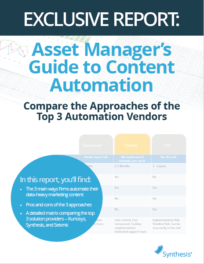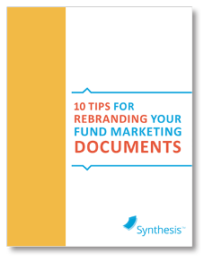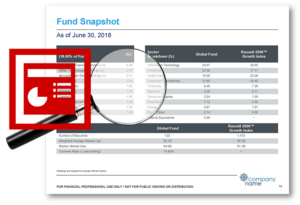The New Tailored Shareholder Rule – What ’40 Act Funds Need to Know
Just Updated:
Synthesis Technology’s Tailored Shareholder Report Planning Guide
In case you missed it, the SEC is mandating that mutual funds and ETFs shift from traditional reporting documents to something sleeker. The old reports ran dozens of pages in length and, quite frankly, have been largely ignored by their shareholders. Thus, they are being replaced by something far more useful for the average fund investor.
According to the SEC press release:
“Shareholder reports are amongst the most important documents that fund investors receive… These reports, however, often are more than 100 pages in length. As a result, a retail investor looking to understand the performance, fees, and other operations…may need to sift through extensive financial information. Today’s final rules will require fund companies to share a concise set of materials that get to the heart of the matter.”
Beginning in July 2024, mutual fund and ETF shareholders will begin receiving “Tailored Shareholder Reports.” These will be shorter, with a “visually engaging” format, and a stricter focus on the information that would be most relevant and of interest to the average shareholder.
This rule change will allow retail shareholders to more easily assess and monitor their fund investments via documents that are concise, relevant, and written in plain (read: non-jargony) English.
Client Success Story: A Marketing Team That Can Now Market
Synopsis: $27+ billion asset manager engaged Synthesis to automate their fact sheet production after failed attempts at automation with other vendors. The result?
- Quarterly time-to-market with updated collateral fell by 70%, with a corresponding decline in internal resource allocation
- Because they were no longer focused on sales product support for 24 weeks a year (the total length of time spent managing quarter-end data production), the Marketing team could focus on core marketing functions
- They were able to fully invest themselves in projects which added significant value to the firm’s overall brand
- As a result, management approved higher budgets, more staffing, and a significantly broadened project portfolio.
It is easy for asset management marketing and sales teams to understand the benefits of data and marketing collateral automation.
Why? Because automation:
- Saves time
- Improves efficiency
- Reduces opportunity costs, and
- Enables stronger alignment across the marketing, sales, and compliance departments.
Understanding is one thing, but convincing upper management to add budget line items for new relationships is often tough – especially when their impact often escapes the usual bottom-line KPIs.
Synthesis has an asset management client with $27+ billion AUM, whose marketing director faced exactly this sort of pushback when the relationship was initiated. Here’s their story:
The SEC’s New Modern Marketing Rule: Are You Prepared to Comply?

You’re probably already aware of SEC’s Modern Marketing Rule (Rule 206(4)-1), which replaces previous rules governing advertising by registered investment advisers, including asset managers and private funds.
You may even know these rules are scheduled to go into effect on November 4, 2022.
But does everyone in your firm who is involved in communicating with the public understand the new requirements? And, more importantly, is your firm on track toward meeting these requirements?
If you’re not, you’re not alone. According to Red Oak Compliance Solutions, less than 25% of their clients admit that they’ve fully instituted processes for complying with Rule 206(4)-1.
The good news is that most print and online marketing and advertising materials that asset managers produce already comply with SEC requirements.
However, the SEC’s new rules are designed to close certain loopholes, particularly concerning the way performance information is presented, as well as encompass the reality that messaging platforms like email and social media have become as important as pitchbooks, and web sites in conveying marketing and sales information to clients and prospects.
And, if that wasn’t enough, the SEC will now require asset managers to provide extensive documentation of the processes they used to create, review, approve and distribute advertising materials.
Is there a silver lining here? Perhaps, since the SEC is finally going to allow asset managers to use client testimonials and endorsements in their advertising.
Let’s take a closer look at the key provisions that will create the most work for asset managers—and what they need to do now to comply with the new rules.
Thinking Outside the Box to Engage Financial Advisors and Grow AUM

Over the past couple of years, the way we live, work and communicate has been changed forever. The global pandemic left an indelible mark on the asset management landscape that requires new strategies for engaging both clients and employees. So how do asset managers attract and engage financial advisors and grow assets in a more distributed and remote workforce?
This topic was explored at length at the Spring 2022 IMEA conference in Chicago. Some of take-aways from the event are included in our tips below:




 Compare the Top 3 Finserv Content Automation Vendors [White paper]
Compare the Top 3 Finserv Content Automation Vendors [White paper] Create Pitchbooks the Drive Sales [White paper]
Create Pitchbooks the Drive Sales [White paper] Build vs. Buy: Should Your Financial Services Firm Outsource or Insource Marketing Technology? [White paper]
Build vs. Buy: Should Your Financial Services Firm Outsource or Insource Marketing Technology? [White paper]  10 Tips for Rebranding your Fund Marketing Documents [White paper]
10 Tips for Rebranding your Fund Marketing Documents [White paper]




